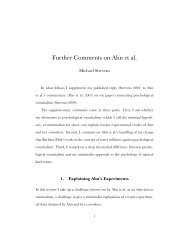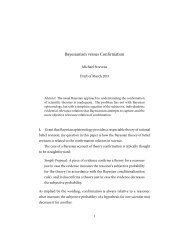The Essentialist Aspect of Naive Theories - Michael Strevens
The Essentialist Aspect of Naive Theories - Michael Strevens
The Essentialist Aspect of Naive Theories - Michael Strevens
You also want an ePaper? Increase the reach of your titles
YUMPU automatically turns print PDFs into web optimized ePapers that Google loves.
Finally, the fifth defense <strong>of</strong> pure essentialism is to suggest that water is<br />
represented as having an essence other than “at least 70% (or some other<br />
proportion) H 2 O”. This goes against the usual essentialist line (see especially<br />
Atran (1990)) that as children mature into adults, their theories become<br />
more and more like the currently accepted scientific theories, since if<br />
chemistry attributes any essence to water, it is H 2 O. But suppose that, for<br />
the sake <strong>of</strong> saving the hypothesis, the pure essentialist retracts this claim.<br />
<strong>The</strong>n pure essentialism owes us some suggestion as to what the represented<br />
essence <strong>of</strong> water is, such that it includes swamp water, the stuff in<br />
a radiator, and sewer water, but not tea, blood, or grapefruit juice. <strong>The</strong>re<br />
is a very strong constraint: the K-patterned projections and especially the<br />
K-patterned categorizations rule out appearances and behavior as possible<br />
constituents <strong>of</strong> this essence. Thus a description <strong>of</strong> the essence must not mention<br />
the appearance or the chemical behavior <strong>of</strong> water. But what do people<br />
know <strong>of</strong> water, apart from its look, its behavior, and the fact that “water<br />
is H 2 O”? Nothing. If there is something that is widely believed to be the<br />
essence <strong>of</strong> water, and that has nothing to do with looking like water or behaving<br />
like water, it must be something to do with H 2 O. But what could<br />
that something be but the proportion <strong>of</strong> H 2 O? <strong>The</strong>re may be something<br />
that I have not thought <strong>of</strong>; it is up to the pure essentialist to say what it is. I<br />
might add: since we all represent water as having this essence, why doesn’t<br />
it spring to mind when summoned?<br />
Before concluding, I will make one more point in favor <strong>of</strong> the minimal<br />
hypothesis. <strong>The</strong> minimal hypothesis suggests a partial explanation <strong>of</strong> the fact<br />
that some things with high H 2 O content are not counted as water. It will be<br />
noted that the non-waters—such as tea, juice, blood, and disinfectant—have<br />
special chemical (or biochemical) properties in addition to those possessed<br />
by water. It is our knowledge <strong>of</strong> these additional properties, I tentatively<br />
suggest, that prevents us from categorizing the fluids as water. For example,<br />
we know the following causal law: disinfectant kills germs. But we also know<br />
that this law is not true <strong>of</strong> water. So we infer from the germ-killing ability <strong>of</strong><br />
disinfectant that it is not a kind <strong>of</strong> water. 28,29<br />
28. <strong>The</strong> full story must be considerably more complicated than this. For example, chlorinated<br />
tap water is a kind <strong>of</strong> water, but chlorinated water also kills germs (if much less<br />
effectively). Or consider: there are causal laws about sewer water (it smells bad) that are<br />
not true <strong>of</strong> water in general.<br />
29. <strong>Essentialist</strong>s can <strong>of</strong>fer the same explanation. But although we may infer, defeasibly,<br />
from the special properties <strong>of</strong> c<strong>of</strong>fee that it is not water, if we also believe (a) that c<strong>of</strong>fee is<br />
32






